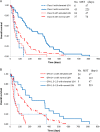Predicting prognosis of short survival time after palliative whole-brain radiotherapy
- PMID: 29069502
- PMCID: PMC5778609
- DOI: 10.1093/jrr/rrx058
Predicting prognosis of short survival time after palliative whole-brain radiotherapy
Abstract
Using existing prognostic models, including the Graded Prognostic Assessment (GPA), it is difficult to identify patients with brain metastases (BMs) who are not likely to survive 2 months after whole-brain radiotherapy (WBRT). The purpose of this study was to identify a subgroup of patients who would not benefit clinically from WBRT. We retrospectively reviewed the records of 111 patients with BMs who were ineligible for surgery or stereotactic irradiation and who underwent WBRT between March 2013 and April 2016. Most patients were scheduled to receive a total dose of 30 Gy in 10 fractions. Non-small cell lung cancer represented the most common primary cancer type (67%), followed by breast cancer (12%). Median survival time (MST) was 109 days (range, 4-883). Univariate analysis identified five factors significantly associated with poor prognosis: performance status (PS) 2-4, perilesional edema, elevated serum lactate dehydrogenase (LDH), using steroids during WBRT, and presence of hepatic metastases. Multivariate analysis confirmed elevated LDH (>300 IU/l) as an independent predictor. MST for LDH >300 IU/l (n = 30) and LDH ≤300 IU/L (n = 87) cohorts were 47 days and 148 days, respectively (P < 0.001). MSTs for GPA 0-1 patients (n = 85) with and without elevated LDH were 37 days and 123 days, respectively (P < 0.001). More than half of the patients with GPA 0-1 and elevated LDH died within two months. Adding elevated LDH to the GPA will permit identification of patients with BMs who have extremely unfavorable prognoses.
Keywords: brain metastases; palliative radiotherapy; prognostic factors; whole-brain radiotherapy.
© The Author 2017. Published by Oxford University Press on behalf of The Japan Radiation Research Society and Japanese Society for Radiation Oncology.
Figures

Similar articles
-
Serum lactate dehydrogenase predicts survival in small-cell lung cancer patients with brain metastases that were treated with whole-brain radiotherapy.J Radiat Res. 2019 Mar 1;60(2):257-263. doi: 10.1093/jrr/rry107. J Radiat Res. 2019. PMID: 30576550 Free PMC article.
-
Hypofractionated stereotactic radiotherapy with or without whole-brain radiotherapy for patients with newly diagnosed brain metastases from non-small cell lung cancer.J Neurosurg. 2012 Dec;117 Suppl:49-56. doi: 10.3171/2012.7.GKS121071. J Neurosurg. 2012. PMID: 23205789
-
KPS/LDH index: a simple tool for identifying patients with metastatic melanoma who are unlikely to benefit from palliative whole brain radiotherapy.Support Care Cancer. 2016 Feb;24(2):523-528. doi: 10.1007/s00520-015-2793-7. Epub 2015 Jun 24. Support Care Cancer. 2016. PMID: 26105515
-
Outcome and prognostic factors in patients with brain metastases from small-cell lung cancer treated with whole brain radiotherapy.J Neurooncol. 2017 Aug;134(1):205-212. doi: 10.1007/s11060-017-2510-0. Epub 2017 May 30. J Neurooncol. 2017. PMID: 28560661
-
Karnofsky performance status and lactate dehydrogenase predict the benefit of palliative whole-brain irradiation in patients with advanced intra- and extracranial metastases from malignant melanoma.Int J Radiat Oncol Biol Phys. 2013 Mar 1;85(3):662-6. doi: 10.1016/j.ijrobp.2012.06.009. Epub 2012 Aug 15. Int J Radiat Oncol Biol Phys. 2013. PMID: 22901382
Cited by
-
Stereotactic radiation therapy for breast cancer in the elderly.Transl Cancer Res. 2020 Jan;9(Suppl 1):S86-S96. doi: 10.21037/tcr.2019.07.18. Transl Cancer Res. 2020. PMID: 35117950 Free PMC article. Review.
-
Role of perilesional edema and tumor volume in the prognosis of non-small cell lung cancer (NSCLC) undergoing radiosurgery (SRS) for brain metastases.Strahlenther Onkol. 2019 Aug;195(8):734-744. doi: 10.1007/s00066-019-01475-0. Epub 2019 May 23. Strahlenther Onkol. 2019. PMID: 31123785 English.
-
Glasgow prognostic score for assessing the efficacy of whole-brain radiation therapy in cases of recursive partitioning analysis class 2 and class 3 multiple brain metastases: a retrospective study.Acta Neurol Belg. 2024 Feb;124(1):231-239. doi: 10.1007/s13760-023-02384-x. Epub 2023 Sep 25. Acta Neurol Belg. 2024. PMID: 37747688 Free PMC article.
-
Effect of whole-brain radiotherapy with platinum-based chemotherapy in non-small cell lung cancer patients with multiple metastases including brain metastases.Sci Rep. 2023 Aug 14;13(1):13173. doi: 10.1038/s41598-023-40235-0. Sci Rep. 2023. PMID: 37580499 Free PMC article.
-
LabBM Score and Extracranial Score As New Tools for Predicting Survival in Patients with Brain Metastases Treated with Focal Radiotherapy.Cureus. 2020 Apr 11;12(4):e7633. doi: 10.7759/cureus.7633. Cureus. 2020. PMID: 32399365 Free PMC article.
References
-
- Barnholtz-Sloan JS, Sloan AE, Davis FG et al. . Incidence proportions of brain metastases in patients diagnosed (1973 to 2001) in the Metropolitan Detroit Cancer Surveillance System. J Clin Oncol 2004;22:2865–72. - PubMed
-
- Borgelt B, Gelber R, Kramer S et al. . The palliation of brain metastases: final results of the first two studies by the Radiation Therapy Oncology Group. Int J Radiat Oncol Biol Phys 1980;6:1–9. - PubMed
-
- Zimm S, Wampler GL, Stablein D et al. . Intracerebral metastases in solid-tumor patients: natural history and results of treatment. Cancer 1981;48:384–94. - PubMed
-
- Egawa S, Tukiyama I, Akine Y et al. . Radiotherapy of brain metastases. Int J Radiat Oncol Biol Phys 1986;12:1621–5. - PubMed
MeSH terms
LinkOut - more resources
Full Text Sources
Other Literature Sources
Medical
Miscellaneous

